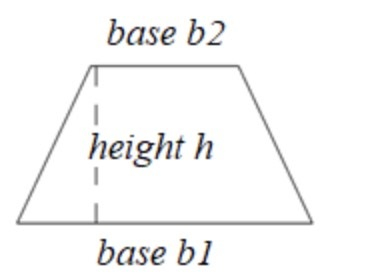Golang 如何查找梯形的面积
在本教程中,我们将看到Golang程序来寻找梯形的面积。面积是指任何封闭图形所覆盖的总空间。

公式
梯形的面积 – ½ * (b1 + b2) * h
b1 – 梯形的一条平行边的长度
b2 – 梯形的另一平行边的长度
h – 梯形的平行边之间的距离。
例如,梯形的一条平行边的长度是10厘米,另一条平行边的长度是8厘米,它们之间的距离是4,所以梯形的面积是-。
b1 = 10 cm
b2 = 8 cm
h = 4 cm
Area = ½ * (a + b) * h
= ½ *( 10 + 8) * 4
= ½ * 18 * 4
= 9 * 4
= 32 cm^2
在函数中寻找梯形的面积
算法
第1步 --声明平行边的长度、平行边的距离和float64数据类型的面积的变量。
第2步 --初始化变量。
第3步 – 使用函数内的上述公式求面积。
第4步–打印结果。
Time Complexity:
O(1)
Space Complexity:
O(1)
例1
在这个例子中,我们要在函数中找到梯形的面积。
package main
// fmt package provides the function to print anything
import (
"fmt"
)
func main() {
// declaring the floating variables using the var keyword for
// storing the length of the parallel sides of the Trapezium,
// distance between the parallel sides and also a variable area
// to store Area
var a, b, d, Area float64
fmt.Println("Program to find the Area of a Trapezium.")
// initializing the length of one of the parallel side of a Trapezium
a = 10
// initializing the length of another parallel side of a Trapezium
b = 8
// initializing the length of distance between parallel sides of a Trapezium
d = 4
// finding the Area of a Trapezium
Area = (1.0 / 2) * ((a + b) * d)
// printing the result
fmt.Println("The Area of a Trapezium whose length of the parallel sides and distance between the sides are", a,",", b,",", d, "is", Area, "cm * cm.")
fmt.Println("(Finding the Area of a Trapezium within the function)")
}
输出
% go run tutorialpoint.go
Program to find the Area of a Trapezium.
The Area of a Trapezium whose length of the parallel sides and distance between the sides are 10 8 4 is 36 cm * cm.
(Finding the Area of a Trapezium within the function)
在分离函数中寻找梯形的面积
算法
第1步 --声明平行边的长度、平行边的距离和float64数据类型的面积的变量。
第2步 --初始化变量。
第3步 – 以梯形的平行边长度和the作为参数调用函数,并存储函数返回的面积。
第4步 – 打印结果。
例2
在这个例子中,我们将通过定义单独的函数来求出梯形的面积。
package main
// fmt package provides the function to print anything
import (
"fmt"
)
// in this line we have declared the function that have float64
// type parameter and float64 type returntype
func areaOfTrapezium(a, b, d float64) float64 {
// returning the area by applying the formula
return (1.0 / 2) * ((a + b) * d)
}
func main() {
// declaring the floating variables using the var keyword for
// storing the length of the parallel sides of the Trapezium,
// distance between the parallel sides and also a variable area
// to store Area
var a, b, d, Area float64
fmt.Println("Program to find the Area of a Trapezium.")
// initializing the length of one of the parallel side of a Trapezium
a = 10
// initializing the length of another parallel side of a Trapezium
b = 8
// initializing the length of distance between parallel sides of a Trapezium
d = 4
// finding the Area of a Trapezium by calling the function with the respective parameter
Area = areaOfTrapezium(a, b, d)
// printing the result
fmt.Println("The Area of a Trapezium whose length of the parallel sides and distance between the sides are", a,",", b,",", d, "is", Area, "cm * cm.")
fmt.Println("(Finding the Area of a Trapezium in the separate function)")
}
输出
Program to find the Area of a Trapezium.
The Area of a Trapezium whose length of the parallel sides and distance between the sides are 10 , 8 , 4 is 36 cm * cm.
(Finding the Area of a Trapezium in the separate function)
总结
以上是在Golang中寻找梯形面积的两种方法。第二种方法在模块化和代码重用性方面要好得多,因为我们可以在项目的任何地方调用这个函数。
 极客教程
极客教程